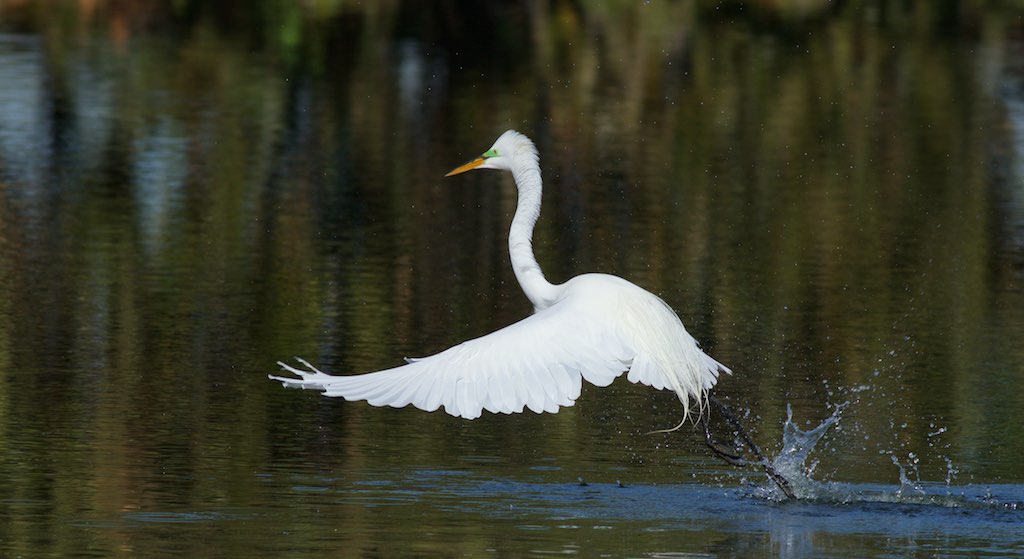Visitors on a prairie and wetland tour at Goose Pond on July 31st were treated to seeing a group of eight great egrets. Even at a great distance, the state-threatened great egret is difficult to confuse with any other Wisconsin bird. Pure white feathers, a five-foot wingspan, and long graceful wing beats make great egrets pop out against any backdrop. These birds are widespread in the United States, and the northern portion of their range cuts through Wisconsin along the tension zone.
Great egret on the water, photo by Arlene Koziol
Great egrets eat primarily fish, but they will also feed on frogs, reptiles, and other birds. They arrive in Wisconsin during April. Soon after, males claim a nesting site, begin building nests, and display fabulous white plumes to attract mates.
Great egrets were almost hunted to extinction in the 1800’s for their showy plumes which were a sign of status and fashion in ladies’ hats. George Bird Grinnell (yes, his middle name was Bird) was shocked by the mass killing of great egrets and other birds for superfluous reasons. In 1886, Grinnell formed a conservation organization geared toward bird protection dubbed National Audubon Society after a revolutionary bird painter named John James Audubon. The National Audubon Society retains the great egret as their logo to this day.
While most great egrets’ nest in colonies with others of the same species, pairs of great egrets are occasionally observed nesting among great blue heron colonies. Nests are constructed with sticks and twigs up to 100 feet off the ground. If the same colony nesting site is used repeatedly, guano buildup can change soil chemistry leading to increased tree disease. Tree diseases, colony nesters, high nests, and wind storms can add up to terrible consequences. The entire year’s breeding effort for a colony can be destroyed in a day, making this species susceptible to drastic local population changes. This is a major challenge in Wisconsin where populations are already low, but less so in more southern states with higher great egret populations and more abundant quality habitat.
Great egret nestling, photo by Arlene Koziol
In the Atlas of the Breeding Birds of Wisconsin Bill Volkert wrote “By the early 1970’s some 250 pairs nested on Fourmile Island in the southern part of Horicon Marsh.”
In Breeding Bird Atlas I, great egrets were found nesting in 10 sites and only two sites contained over 10 breeding pairs. In mid-May 1998, there were 550 nesting pairs of great blue herons and great egrets at Fourmile Island State Natural Area. Unfortunately, this rookery was destroyed in a late May thunderstorm with 100 mile per hour winds.
In Breeding Bird Atlas II, great egrets were found at 15 sites in 10 counties with only two or three sites with over 10 breeding pairs. Many of the great egret sites were associated with great blue heron colonies. Andy Paulios, DNR Wildlife Biologist, visited Four-mile Island during the peak of the nesting season in June 2019 and only found five great blue herons and only a couple of nests.
Sightings of great egrets increases as the summer progresses. Instead of Wisconsin grown birds, these are likely egrets that disperse north from Illinois for a short time in search of better food resources. In late July and August, we frequently see great egrets and on occasion there maybe 30 to 40 in wetlands that are going try where they are feeding.
Great egret in the cattails, photo by Arlene Koziol
According to ebird records the largest number of great egrets at Goose Pond Sanctuary was 10 seen by Kyle Lindemer on October 16, 2015. That is, until this morning. The new record as of 9:00 a.m. today is 18, as counted by Graham and the four Prairie Partner interns.
On August 1st the eight egrets were easy to see, especially the four perched in the large bur oak near the railroad tracks. We also saw 11 great blue herons perched in the bur oak or fishing in the wetlands. We hope you can visit Goose Pond to see we these beautiful wading birds.
Written by Mark Martin and Susan Foote-Martin, Goose Pond Sanctuary resident co-managers
Graham Steinhauer, Goose Pond Sanctuary land steward
Cover photo by Arlene Koziol









